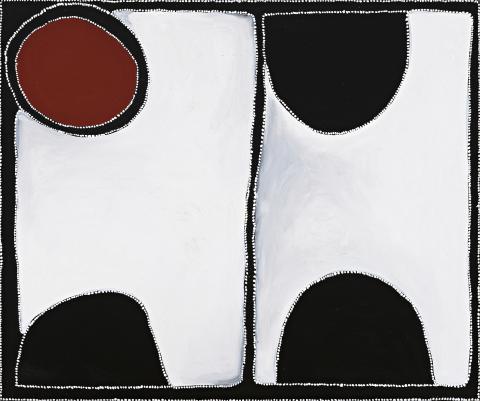LIGHTNING CREEK – BUSH TURKEY, 2003
PADDY NYUNKUNY BEDFORD
ochres and pigment with acrylic binder on linen
150.0 x 180.0 cm
signed with initials verso: PB
bears inscription verso: title and Jirrawun Arts cat. PB 7-2003-158
Jirrawun Arts, Kununurra
Private collection, Melbourne, acquired from the above in 2004
Storer, R., Paddy Bedford, Museum of Contemporary Art, Sydney, 2006, p. 153 (illus.)
Lerndijwaneman or Lightning Creek is the site where Birnkirrbal, the ancestral Bush Turkey made camp after she had left the Emu at Garnanganyjel (Mount King). It lies at the northern end of Paddy Bedford’s country, along the Wilson River in the shadow of the Durack Range. The Turkey had travelled a long distance and stopped at Lerndijwaneman to rest and eat a little fruit called gawoorroony. As Paddy Bedford narrates the story, here she ‘… went to sleep on the red ground … Because the Turkey did that, we all sleep at night.’ Lerndijwaneman is also the place where another ancestor, Nightjar, in the form of a man flaked stone to make spearheads.1
The painting was made during a particularly productive time for the artist. In 2000, along with his brother-in-law Timmy Timms, Bedford revealed a public song cycle or joonba performance about the massacres of Gija people on Bedford Downs station in the early twentieth century. It was adapted by the Neminuwarlin Performance Group as Fire, fire burning bright who perfomed the joonba at the Perth International Arts Festival and in Melbourne in 2002. The Emu Dreaming site at Garnanganyjel (Mount King) is the place a group of Gija were poisoned with strychnine. Bedford’s work featured in two major exhibitions that recounted those violent times in the eastern Kimberley when cattle stations were established and ancient hunting grounds were depleted: Blood on the Spinifex opened at the Ian Potter Museum of Art at the University of Melbourne, in late 2002, and in the following year the Art Gallery of New South Wales mounted True Stories: Art of the East Kimberley. Paddy Bedford was also among a group of eight Indigenous artists to be commissioned by the Musée du quai Branly in Paris to produce designs for the new building which opened in 2006. His design was transformed into ceramic-fired glass. Later that year the Museum of Contemporary Art, Sydney, mounted a retrospective exhibition of his work that toured to the AAMU Museum of Contemporary Aboriginal Art, Utrecht, the Netherlands.
1. Storer, R., Paddy Bedford, Museum of Contemporary Art, Sydney, 2006, p. 80
WALLY CARUANA
